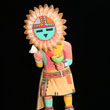
Hopi Kachina Dolls
Kachinas (Katsinam in Hopi) play an important part in the lives of Pueblo Indians in Arizona and New Mexico, especially the Hopi and Zuni nations. They represent the spirit of many things in the natural world, ranging from animals and plants, weather elements a. m. all the way to human qualities and attributs. The Kachinas live amongst the tribes for six months every year. They bring presents, dance in the kivas (i.e. ceremonial rooms underground) and village plazas, and help the tribal members to pray for rain and a good harvest season. Some Kachinas use humor to teach the children correct ways of living, others use strength to correct misbehaviour, and to remind of the duties of each tribal member to contribute to the society. There are approx. 300 different documented Kachinas.
The Kachina dolls are carved from dried roots of the cottonwood tree, then decorated and painted, and serve as a representation of a Kachina spirit with its characteristic qualities. Since only males members of the society are allowed to personify Kachinas in ceremonies, the dolls were traditionally given to young children, to help them connect with the spirit of the Kachina, and to teach them of the Kachina's qualities. For more than 100 years Non-Indians have been fascinated by these dolls, and have tried to acquire them for museums and private collections. During the last 50 years more and more native carvers have decided to produce such dolls for tourists and a growing collector's market.
To get a detailed description of each item click on image in table.
| Next | Last | ||
| Next | Last | ||

















